










April 28, 2006 - Post No. 67

Because Bishop Daron will be leaving tomorrow, Saturday, Fr. Goossan and Bishop Aris decide to organise a tour of the Galilee for him, and Fr. Kegham and I are invited to go along for the ride. Sarkis is our driver today, and I tell him about the three drivers at the Catholicosate in Antelias named Sarkis, Sarkis and Sarkis. Perhaps St. Sarkis is the Armenian patron saint of drivers?? (or, if not, he should be!)
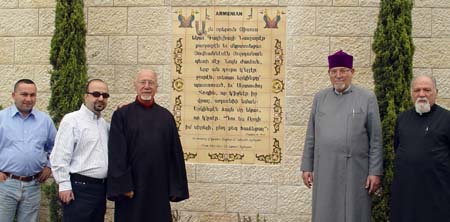
l-r, Sarkis, Fr. Goossan, Bishops Daron & Aris, and
Fr. Kegham -- posing beside the Armenian translation of Mark 1.9-11 at
the Baptism Site on the River Jordan.
We stop for breakfast in a pleasant picnic area along the way, and then, about an hour later, pull into the Baptism Site on the Jordan River, very near where it flows out the Sea of Galilee. Pictured at the top of this post, the members of a group of Albanian pilgrims renewing their baptismal vows under the leadership of their orthodox priest.
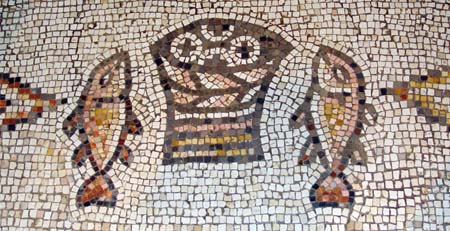
Our next stop is Tabgha, the traditional site for the multiplication of the loaves and fishes in the Gospel narrative. I am very fond of this monastery, particularly the ancient mosaics in the basilica, including this one, possibly the most famous of early Christian patterns in the Holy Land.
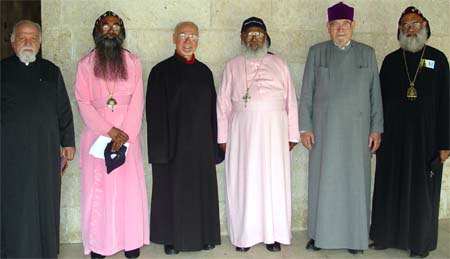
Just outside the basilica, we meet a group of visitors from the
Malankara Orthodox Syrian Church based in Kerala, India, including the
Archbishop of Bonbay, mar Geevarghese Coorilos, pictured right. The
Malankara or Mar Thomas Christians, claim to have been founded by the
Apostle St. Thomas who brought the Gospel message to
India in the first century of Christianity. The Malankara Orthodox are
related to the Syrian Orthodox, are part of the Oriental Orthodox family
of churches, and they are, as such, in communion with the Armenian Orthodox.
So the chance encounter is particularly fortuitous! There is some talk
of the Cathedral hosting a Malankara liturgy at some point before
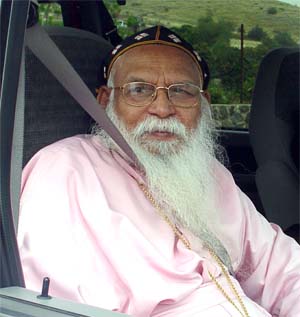 they
return home to India on Monday.
they
return home to India on Monday.
It happens that His Holiness, the Catholicos of the Malankara Orthodox is traveling with the group. A bit too elderly for wandering around the holy sites, His Holiness Baselio Marthoma Didymus the First, is waiting for his brethren in their tour van. So we take the opportunity to meet the holy father, and Bishop Aris, ecumenical officer for the Armenian Patriarchate, is particularly please to extend the greetings of the Armenians in Jerusalem to the Catholicos.
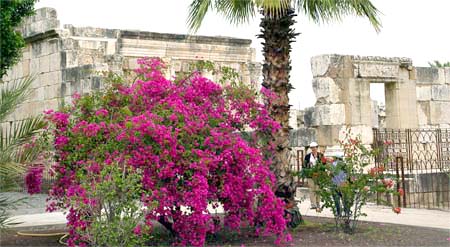
We stop at the ruins of the village of Capernaum (pictured above) before going onto the Shrine of the Beatitudes (pictured, below), the traditional site of the Sermon on the Mount (Matthew 5 ff.)
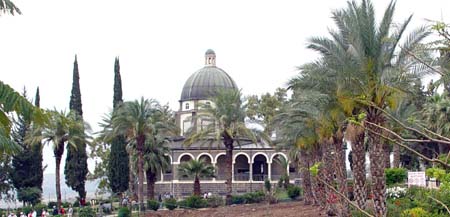
On our way back towards Tiberias, we stop at a Lebanese restaurant, where we enjoyed a splendid array of mezze dishes and dips, and a serving of St. Peter's fish -- a domestic fish developed from the smaller fish of the same name that is native to the Sea of Galilee.
Fr. Goossan offers a round of toasts during our lunch together, in each he focuses on one of the members of our small company of pilgrims, thanking each for his gifts and presence among us. When it comes to yours truly, Fr. Goossan makes me an honorary Armenian, much to my delight! Then, Bishop Daron completes the circle, lifting his glass in honour of the ever generous Fr. Goossan.
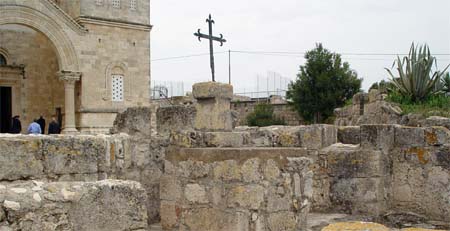
Our next stop is Mount Tabor, the traditional site of the Transfiguration, when our Lord was transfigured, brilliant as the sun, and seen in the company of Moses and Elijah. The ruins of an ancient monastic chapel can be seen above, in front of the new building from the late 1800s.
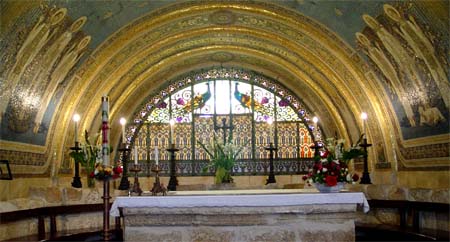
Mt. Tabor is a lovely site with a superb view and a beautiful church decorated in bright mosaics. This is my first visit to Mount Tabor in three trips to the Holy Land, and I am pleased to discover the beauty of this lofty sanctuary.
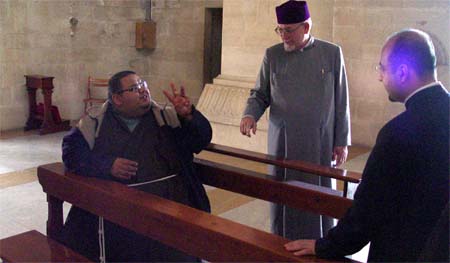
We talk with the portly friar keeping watch in the monastery church who tells us that the community here has three friars, three sisters, and one cow -- we have already spotted the latter enjoying the flower garden beside the church.
Once again, I am impressed with the linguistic dexterity of many I have met during my visit to the Middle East. Through the course of the day, not only is there easy conversations in Arabic, like the one with the friar, but similar conversations as required in Hebrew. In addition to Armenian, I will also hear a conversation in Russian, and share in several in either English and French. Six spoken languages in a single day, not bad!
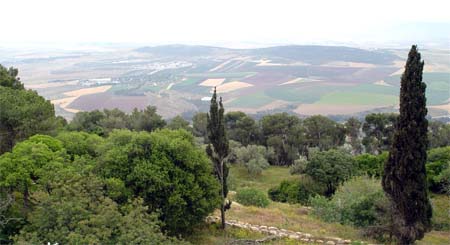
The view from Mount Tabor is wonderful, as one might well imagine. It is a rather hazy day, but we can still see for miles and miles from the observation platform beside the church.

From Mount Tabor we drive to Nazareth, passing through the village of Cana and the traditional site of the wedding feast where Jesus is said to have performed his first "sign," as reported in the Gospel of John. There is a similar site in southern Lebanon, which I visited in March (cf. "Never Tyre of Sidon.")
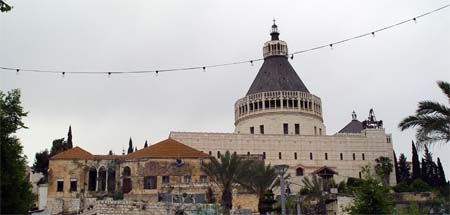
In Nazareth, we make our way to the new Basilica of the Annunciation on one of the hillsides of the city.
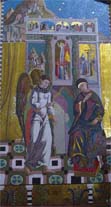 |
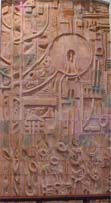 |
 |
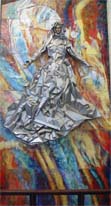 |
| Australia | Canada | Wales | USA |
The basilica is a contemporary building, post Vatican II, and features a wonderful collection of large mosaic, ceramic or pottery tiled images of St. Mary the Mother of God, each about 8 meters in height, given to the basilica by catholic believers from many of the countries of the world.
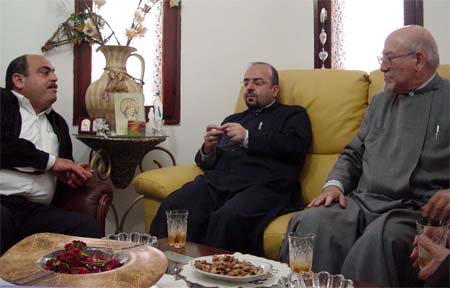
Bishop Aris (right) and Fr. Goossan take the opportunity of our time in Nazareth to touch base with their friend and associate, CÚsar, an Arab Israeli who is the official liaison in the Israeli Ministry of the Interior with the Christian communities in the country. He welcomes us to his apartment with all of the courtesy of Palestinian Christian hospitality: salted nuts, whisky, fresh fruit, coffee, chocolates, and plenty of agreeable company.
Bishop Aris and Fr. Goossan take pains to review the incidents of last week's ceremony of the Holy Fire. There were 3,000 police which Bishop Aris considers about 2,000 too many, and about 1,000 pilgrims who were excluded from entering the Church of the Resurrection ostensibly due to a lack of space for them. Simple solution, fewer police and more pilgrims in 2007! CÚsar doesn't seem too convinced that this can be worked out with the Jerusalem authorities, but agrees that it is worth a try.
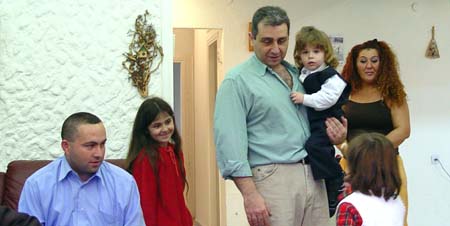
We make one more stop on our way home to Jerusalem, this time in Haifa on the coast of Israel to visit old friends of Bishop Aris and our driver Sarkis. It is a large family, gathering on the eve of the Sabbath, the first night of the weekend. It is also the birthday of the youngest member of the family, a two year old whom we saw briefly on our arrival (pictured in his father's arms, above, his aunt and cousins looking on.)
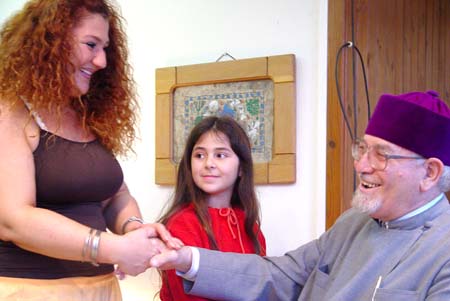
Verjeen's son is married to a Russian Israeli who immigrated with her family thanks to the Israeli law that makes immigration to Israel a right for anyone of Jewish descent. In the case of the Verjeen's in-laws, they are half Jewish, but really consider themselves Urkanian and orthodox Christian. The migration is far from over, the conversation tonight was dominated with details of plans to immigrate -- everyone but Varjeen and Mihran -- to to the States, where Verjeen's son-in-law has only recently gone with his brand new green card to await citizenship in five years time.
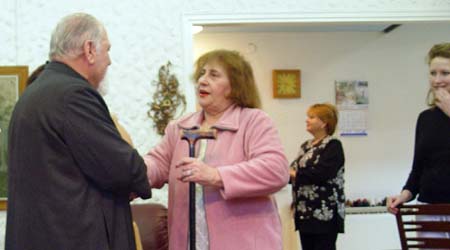
On entering the room after our arrival, Verjeen goes directly to Fr. Kegham, shakes her finger at him saying, "I know who you are!" Fr. Kegham has only just returned to Jerusalem after 42 years in ministry in parishes around the Armenian world, but mostly in the USA, and it turns out the he performed the wedding liturgy for Verjeen and her husband Mihran (pictured here).
This was well over 40 years ago, when Fr. Kegham was a young priest, still
serving in Jerusalem.
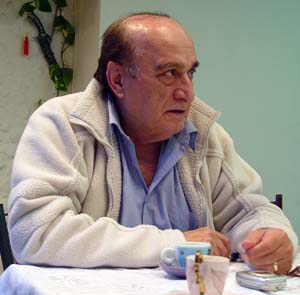 Mihran lived in the Armenian Quarter of the Old
City at that time, but had met a beautiful young woman from Haifa one
year when
she came with her family to celebrate Christmas in Bethlehem
with the Armenian community.
Mihran lived in the Armenian Quarter of the Old
City at that time, but had met a beautiful young woman from Haifa one
year when
she came with her family to celebrate Christmas in Bethlehem
with the Armenian community.
In those days, Fr. Kegham explains, it was nearly impossible to get a visa to leave the old city of Jerusalem, then part of Jordan, to visit Haifa in Israel. Fr. Kegham had a visa because he took services in the Israeli territories. At Mihran's request, Fr. Kegham agreed negotiate on Mihran's behalf the possibility of marriage with Verjeen's father.
Mihran, who ran a photo shop in the Old City in those days, gave Fr. Kegham a camera to take photos of the prospective bride, and Fr. Kegham reports that Mihran's heart really started to swoon when he caught site of the developed photos!
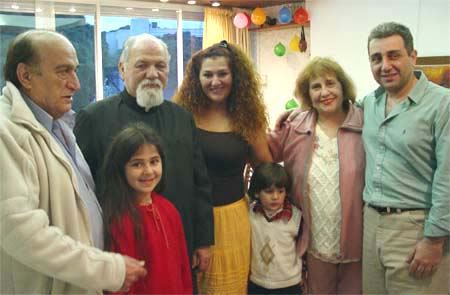
So this is another photo, above, this time of the reunion of the happy company more than 40 years later. Pictured here Fr. Kegham, Verjeen, her husband of all these years, Mihran, two of their children, and two of their grandchildren as well.
In one of my reports shortly after arriving in Jerusalem, I reflected on how much I missed the familiarity of Antelias and Bickfaya, and wondered how long it would take to feel at home here. I am happy to report that the water shed was crossed at some point, perhaps on the trip to Galilee, and the Armenian Patriarchate and its people feel very much like home now to me. This, no doubt, in large part the consequence of the many efforts here to make me feel welcome and, as it were, part of the extended family.